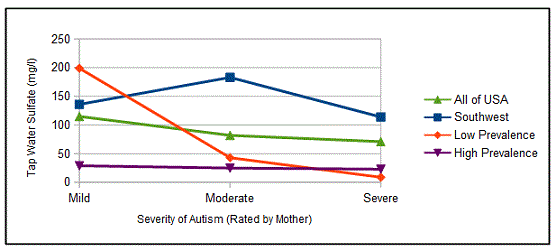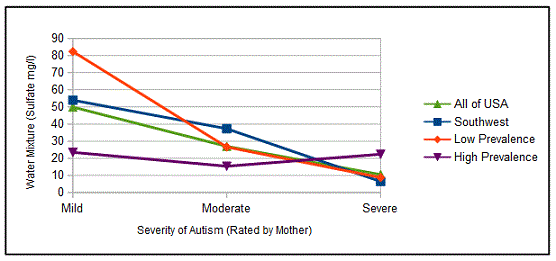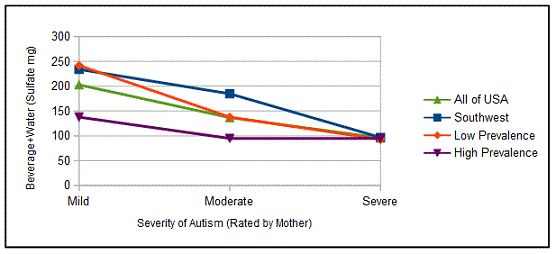Autism
Projects: Facebook Water Study
The basic premise of the Brimstone Theory
is simple: disturbed metabolism of the oxides of sulfur cause autism.
In particular, sulfite is not properly processed resulting in low
levels of beneficial sulfate in blood. Avoiding sulfite in food and
sulfur dioxide in drugs can help. Also, a diet rich in sulfate may be
preventative. Unfortunately, sulfate in our water supply has been
reduced by widespread consumption of purified bottled water and the
well intentioned cleanup of the environment. The
problem is easy to correct by adding sulfate to water or switching to
sulfate rich bottled water. But first, we need to prove the theory is
correct. That was the goal of our research study which is summarized
below from a paper published in the January 2020 edition of the Journal
of Autism and Developmental
Disorders.
Sulfate
Deficiency as a Risk Factor for Autism
Abstract: This is a study of
water and beverages consumed during pregnancy by mothers of children
with autism. The mothers were recruited on Facebook and materials
included vials for water samples and a survey to
describe the water and beverages. Samples were tested for sulfate and
surveys evaluated for average daily levels. Results were stratified for
selected regions of the United States. Areas with the highest rates of
autism showed significantly lower levels of sulfate compared to areas
with low rates of autism (28% sulfate, n=45, p=0.059). Severe autism
was associated with low sulfate levels while mild symptoms were
associated with higher levels of sulfate (-0.32 correlation, n=86,
p<0.01). The results suggest that sulfate may be helpful in reducing
both the incidence and severity of autism.
Introduction: Autism Spectrum
Disorders (ASD) affect social interaction, communication, behavior and
the senses. In the United States, the prevalence is 1 in 59 for all
children and 1 in 37 for boys based on data from the Centers for
Disease Control and Prevention. The cause is not well understood
although genetic predisposition coupled with environmental influence is
strongly suspected. It is the purpose of this study to evaluate sulfate
levels in drinking water and beverages as a risk factor for autism. It
is our goal to better understand the causes of autism and illuminate
possible preventative measures.
Results in Graphical Form: The
results are best visualized with the help of line graphs. Figure 1
plots Tap Water sulfate concentrations for each of the four study
regions as a function of autism symptom severity. The data lines are
widely separated but unsurprising. The Southwest shows relatively high
sulfate simply because it is served by Colorado River water which is
naturally high in minerals. The High Prevalence region reports the
lowest sulfate values in this study, reaffirming water quality reports
from major cities for these states. The Low Prevalence region indicates
high sulfate for mild conditions, dropping sharply for more severe
autism. While the USA as a whole shows a flat, mid-range plot with
little apparent association with symptom severity.
Figure 1. Tap Water Sulfate Levels in
Selected Regions
Figure 2 plots the sulfate concentrations for the Water Mix actually
consumed by the pregnant mothers. This includes tap or well water,
filtered and unfiltered, along with a variety of bottled waters. Again,
each of the four regions is plotted against autism severity. These
curves are surprisingly different from tap water alone. Three of the
four regions suggest a trend, hinting that mild symptoms and higher
sulfate may be related. High Prevalence is the outlier, more or less
flat but on the low end of sulfate.
Figure 2. Water Mixture Reported by
Mothers
The sum of sulfate from Bev & Water is presented in Figure 3. These
are the beverages, tap water and bottled waters that were drunk by the
participating mothers. In this case, sulfate is not a concentration but
the mg weight of the sulfate consumed daily. It was calculated from the
number of 8 ounce glasses reported by each mother for various types of
beverages and water. As in previous figures, each of the regions is
plotted against autism severity. All of the regions now show a
monotonic, decreasing function clearly associating severity with lower
levels of sulfate.
Figure 3. Beverages plus Water
Reported by Mothers
Conclusion: Our survey of the
drinking water and beverages of mothers of children with autism showed
an association between sulfate deficit during pregnancy and autism
severity. There was a clear dose versus response relationship
suggesting that sulfate during pregnancy may be helpful in reducing the
severity of autism. Since the same water was available to the entire
family, sulfate during infancy also may be helpful in reducing the
severity of the condition. Comparing the 8 states with the highest rate
of autism to the lowest, prevalence is reduced by a factor of almost 3
according to Department of Education statistics. Since there is a large
difference in the available sulfate in water from these regions, it may
be possible to significantly reduce the incidence of autism by
supplementing with sulfate rich food and water during pregnancy and
early childhood. Based on losses in urine, 510 mg of sulfate per day
may be an appropriate goal for pregnant women with an elevated risk of
autism. To view the full article, click on the link below.
|

|
Hosted by
Rybett Controls
|

|



